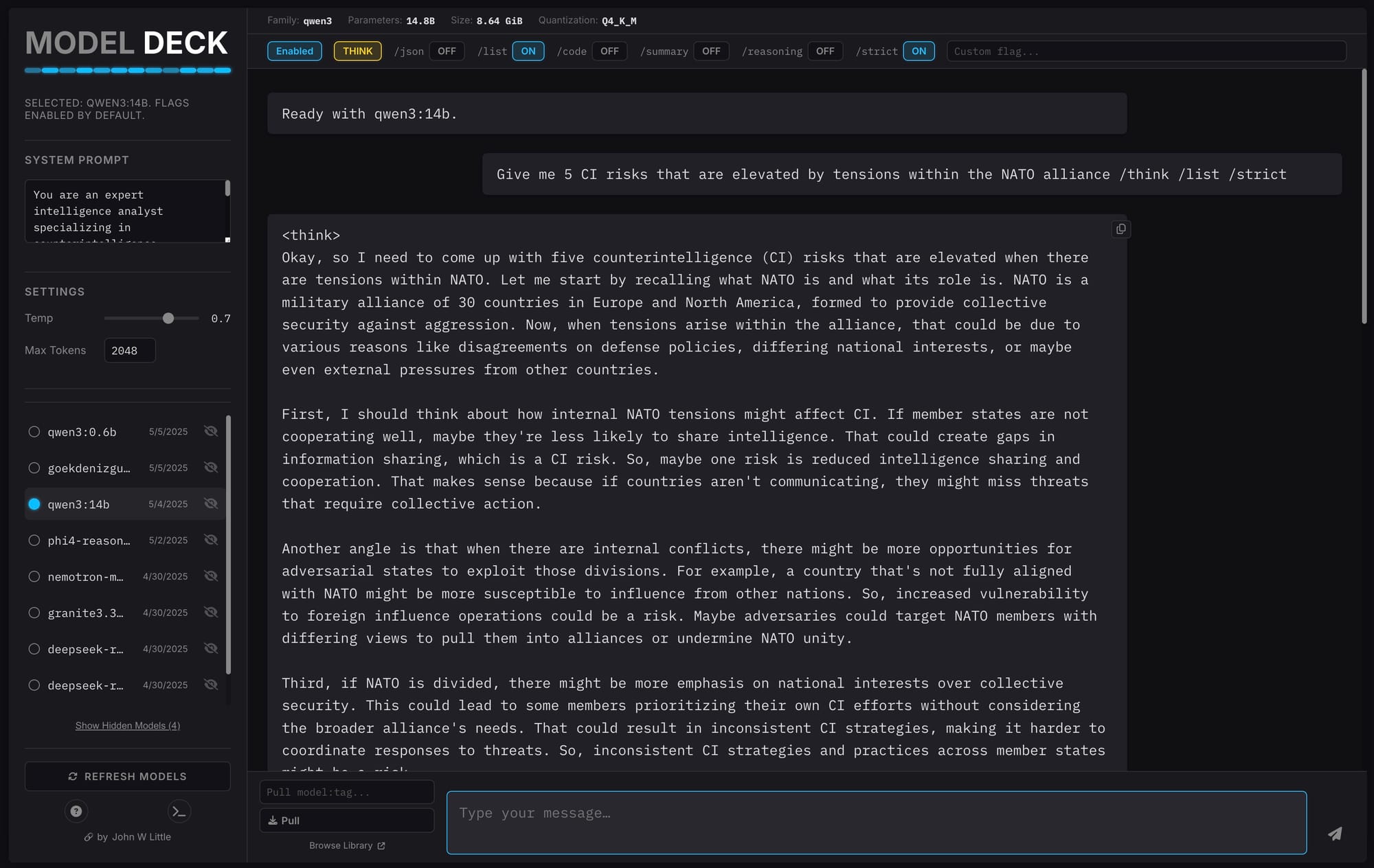Model Deck: A Streamlined Single-File Interface for Ollama LLM Management
Model Deck offers a deliberate counterpoint to feature-heavy LLM interfaces—a single HTML file that streamlines interaction with local Ollama models while providing a solid foundation for custom extensions and experimental workflows.

The Quest for Simplicity in Local AI Interaction
Local large language model deployment has reached an inflection point. With tools like Ollama making powerful AI models accessible on personal hardware, we're witnessing the democratization of capabilities once limited to cloud providers. While comprehensive interfaces like Open WebUI provide extensive features for most users, there remains a need for more focused, lightweight alternatives that prioritize specific workflows.
Model Deck emerges from this precise need—a deliberate exercise in restraint and purpose-driven design. I built this tool as a baseline foundation with the specific intention of extending and customizing it for multiple different use cases, each tailored for specific intelligence functions or specialized workflows. As I explored the landscape of local AI interfaces, I found myself wanting something more streamlined: a single HTML file that could serve as both a practical daily driver and a versatile foundation for future experimentation across various domains.
Why Build Yet Another Ollama Interface?
The existing ecosystem of Ollama interfaces offers impressive functionality, but I had specific requirements that weren't being met in quite the way I wanted:
- Immediate model visibility: The ability to see all locally available models at a glance
- Rapid model switching: Seamless transitions between models for testing and comparison
- Parameter control: Simple adjustment of critical generation variables
- System prompt flexibility: Easy modification without complex configuration
- Streamlined model management: Pulling new models without command line interruptions
- Distraction-free interface: A clean, focused environment for interaction
- Customizable foundation: A platform I could easily adapt for multiple specific use cases
Above all, I wanted a baseline platform that I could extend and customize for various specialized intelligence functions—from research assistants to creative writing aids to data analysis tools. Each would require different prompting strategies, parameter settings, and interface elements, but all would benefit from a common, lightweight foundation.
While I could have adapted existing solutions, building from scratch offered an opportunity to create something precisely tailored to these needs. The result is Model Deck—a self-contained HTML file that accomplishes these specific goals without unnecessary complexity and serves as a versatile starting point for more specialized applications.
Core Functionality Without Compromise
Despite its minimalist approach, Model Deck delivers essential functionality for working with local language models:
- Comprehensive model management: Automatically lists available models, allows selection with a single click, and displays key details when available
- Streamlined chat interface: Traditional message exchange with streaming responses
- Parameter adjustment: Direct control over temperature, token limits, and output flags through intuitive controls
- System prompt integration: Dedicated input field for contextualizing model behavior
- Utility functions: Copy responses with a single click, pull new models with integrated progress tracking
- Organizational tools: Hide rarely-used models from view with persistent preferences
This functionality strikes a balance between simplicity and capability—providing the tools necessary for productive work without overwhelming the interface.
Technical Implementation
Model Deck's architecture reflects its philosophy of simplicity. The entire application exists within a single HTML file, integrating CSS and JavaScript without external dependencies. This approach offers several advantages:
- Portability: The application can be easily shared, backed up, or modified
- Reduced complexity: No build process, package management, or dependency conflicts
- Transparency: All code is immediately accessible for inspection or customization
- Minimal footprint: Low resource requirements for both storage and execution
The tradeoff for this simplicity is a deliberate limitation of features—Model Deck doesn't attempt to match comprehensive interfaces in functionality. Instead, it focuses on providing a solid foundation for specific use cases and future extensions.
Beyond the Baseline: Future Directions
While Model Deck in its current form serves its core purpose effectively, I designed it with extensibility in mind. The single-file architecture provides a clean foundation for adding capabilities like:
- Context management: Saving and loading conversation states
- Prompt templating: Pre-configured prompts for specific use cases
- Model comparison: Side-by-side evaluation of different models
- Performance tracking: Monitoring response times and token usage
- Integration with external tools: Connecting to vector databases or other services
These potential extensions represent the next phase of Model Deck's evolution—moving beyond the baseline while maintaining its focus on simplicity and purpose.
The Value of Focused Tools
In an era of feature-rich applications competing for attention, there's value in tools that do less by design. Model Deck represents a deliberate step back from the "everything for everyone" approach, instead focusing on a specific set of needs for a particular workflow.
This philosophy extends beyond this specific application—it's about recognizing when existing solutions might be excellent but not quite aligned with your specific requirements. Sometimes the best tool isn't the one with the most features, but the one most precisely aligned with your workflow.
Getting Started
Using Model Deck requires minimal setup, assuming you already have Ollama installed and running:
- Save the Model Deck HTML file to your computer
- Start a local web server in the same directory (necessary for browser security reasons)
- Using Python:
python3 -m http.server 8000 - Using Node.js:
npx serve .
- Using Python:
- Access the application at http://localhost:8000 (or the port indicated by your server)
- Select a model from the list and begin chatting
The application directly communicates with Ollama's API running on the standard port (11434), requiring no additional configuration beyond the local web server.
Important Security Note: When launching a local web server, be aware of the security implications. These simple servers typically allow anyone on your local network to access the hosted content. If you're on a public or shared network, consider using firewall settings to restrict access or use more secure server configurations for sensitive environments. Always understand the security context of your environment before launching even a simple web server.
Conclusion: Simplicity as a Feature
Model Deck represents a particular approach to tool building—one that values focus, simplicity, and purpose over comprehensive feature sets. While it may not replace more robust interfaces for all users or all scenarios, it offers a streamlined alternative for specific workflows and provides a foundation for future experimentation.
As local AI deployment continues to evolve, I'm confident that both comprehensive platforms and focused tools like Model Deck will have important roles to play in the ecosystem. The future of AI interaction isn't a single interface that meets all needs, but rather a diverse landscape of tools optimized for different use cases and preferences.
For those who value simplicity and focus in their AI workflows, Model Deck offers a lightweight alternative worth exploring. And for developers looking to build their own interfaces, it provides a starting point that can be extended in countless directions without the overhead of complex frameworks or dependencies.
